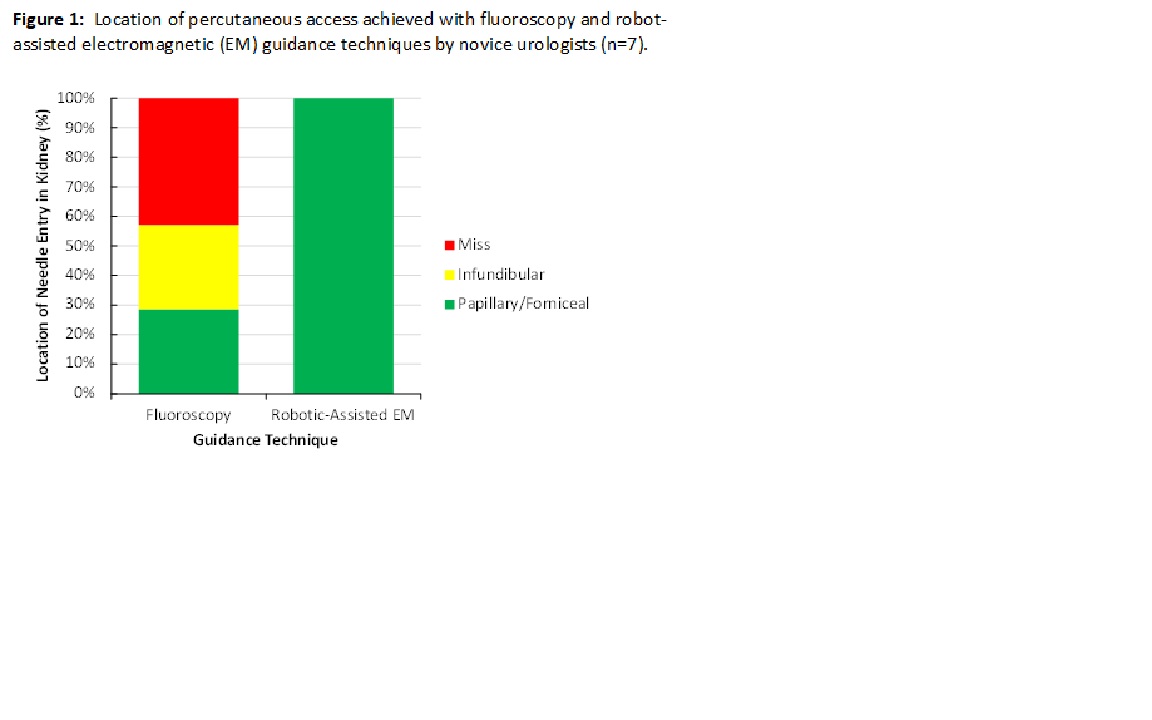Back
Poster, Podium & Video Sessions
Moderated Poster
MP14: Stone Disease: Surgical Therapy (including ESWL) I
MP14-18: Robotic-Assisted Electromagnetic Guidance Improves Success in Gaining Percutaneous Access for Nephrolithotomy by Novices
Friday, May 13, 2022
2:45 PM – 4:00 PM
Location: Room 225
Mitchell Humphreys*, Kevin Wymer, Phoenix, AZ, Ben Chew, Vancouver, Canada, Janet Zhen, Redwood City, CA, Fuad Elkhoury, Los Angelas, CA, Sri Sivalingam, Cleveland, OH, Matthew Dunn, Santa Monica, CA, Michael Borofsky, Minneapolis, MN

Mitchell R. Humphreys, MD
Mayo Clinic Arizona
Poster Presenter(s)
Introduction: Percutaneous nephrolithotomy (PCNL) offers advantages over retrograde intrarenal surgery for large stone burdens. However, gaining optimal access into the renal collecting system can be challenging and requires advanced training. A minority of PCNL access is currently performed by urologists in the USA. In this study, we evaluate the success of gaining percutaneous renal access in a cadaveric model when using a novel robotic-assisted electromagnetic (EM) guidance platform, compared to fluoroscopic guidance, among individuals that do not regularly perform their own PCNL access.
Methods: Seven novices (individuals who use IR for access, or gain percutaneous access <24 times/year, or have gained access <30 times after training) were asked to use robotic-assisted EM guidance provided by the Monarch® Platform, Urology (Auris Health, Inc., Redwood City, CA) to obtain upper pole, mid-kidney, and lower pole access in a modified-supine position vs. the same tasks in a prone position using fluoroscopy in a cadaveric model. The number of puncture attempts, accuracy (papilla/fornix, infundibulum, or miss), and time to achieve access was compared. Participants were also surveyed on their confidence in gaining access (Likert scale 1-5, 5 as the best score). Statistical comparisons were made using paired t-tests.
Results: Novices had increased overall success in gaining percutaneous access using robot-assisted EM navigation compared to fluoroscopy-guided (100% vs. 57%), with greater accuracy (papillary or forniceal) (100% vs. 29%) (Figure 1). Robotic-assisted EM guidance decreased the average number of insertion attempts per calyx (1.24±0.10 vs. 2.98±0.65, p<0.05), and also the time to achieve access (6.92±0.66 min vs. 16.90±3.21 min, p<0.05). Lastly, novices expressed a greater sense of ease [5(3.3-5) vs. 2.5(1-3)] and confidence [5(3.3-5) vs. 2(1-3)] in gaining access using EM- vs. fluoroscopy-guided navigation.
Conclusions: Percutaneous access using robotic-assisted EM-guidance provided by the Monarch® Platform improved access success, time, accuracy, and confidence among study participants. These initial data suggest this novel enabling technology can benefit urologists to routinely gain their own access for PCNL.
Source of Funding: Johnson & Johnson

Methods: Seven novices (individuals who use IR for access, or gain percutaneous access <24 times/year, or have gained access <30 times after training) were asked to use robotic-assisted EM guidance provided by the Monarch® Platform, Urology (Auris Health, Inc., Redwood City, CA) to obtain upper pole, mid-kidney, and lower pole access in a modified-supine position vs. the same tasks in a prone position using fluoroscopy in a cadaveric model. The number of puncture attempts, accuracy (papilla/fornix, infundibulum, or miss), and time to achieve access was compared. Participants were also surveyed on their confidence in gaining access (Likert scale 1-5, 5 as the best score). Statistical comparisons were made using paired t-tests.
Results: Novices had increased overall success in gaining percutaneous access using robot-assisted EM navigation compared to fluoroscopy-guided (100% vs. 57%), with greater accuracy (papillary or forniceal) (100% vs. 29%) (Figure 1). Robotic-assisted EM guidance decreased the average number of insertion attempts per calyx (1.24±0.10 vs. 2.98±0.65, p<0.05), and also the time to achieve access (6.92±0.66 min vs. 16.90±3.21 min, p<0.05). Lastly, novices expressed a greater sense of ease [5(3.3-5) vs. 2.5(1-3)] and confidence [5(3.3-5) vs. 2(1-3)] in gaining access using EM- vs. fluoroscopy-guided navigation.
Conclusions: Percutaneous access using robotic-assisted EM-guidance provided by the Monarch® Platform improved access success, time, accuracy, and confidence among study participants. These initial data suggest this novel enabling technology can benefit urologists to routinely gain their own access for PCNL.
Source of Funding: Johnson & Johnson


.jpg)
.jpg)